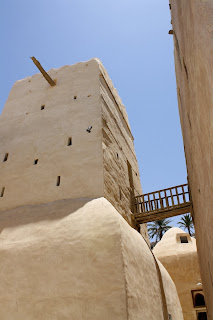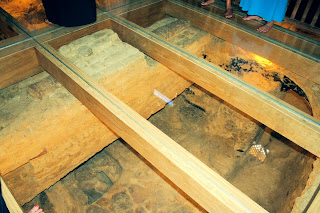One of the many reasons why I wanted to visit Egypt is to SEE Islam without western filters and editing. After 9/11, I had a Muslim student speak to the class about what Islam is really about. Islam is not terrorism, despite what western media portrays it to be. Islam is very similar to Judaism and Christianity, but has it's own unique qualities that make it stand out from the rest. Seeing Islam weaving it's magic throughout Cairo is such an amazing experience because there is so much to see! In the USA, we have an expression, "There is a Starbucks on every corner." In Cairo, the expression is "There is a mosque on every corner!" There is so much beauty in Islam that one needs to break down the stereotypes of the media, in order to fully appreciate all that it has to offer.
 |
| A mosque on every corner! |
Islam was founded by Mohammed, a merchant who was born around 570 AD in Mecca. At the age of 40, he began to receive revelations of the word of Allah (God) and these were transcribed as the Qu'ran (Koran). Mohammed's preachings were not well received in Mecca and, in 622 AD, he and his followers fled to Medina. This flight (hejira) constitutes year zero in the Islamic calendar.
The Qu'ran is the holy book of Islam, is regarded as the direct word of Allah. Muslims believe that it can only be fully understood if read in Arabic. It is divided into 114 chapters, or suras, which cover many topics, including matters relating to the family, marriage, and legal and ethical concerns.
 |
| A Handwritten Qu'ran at the Arab League |
 |
| A Muslim reading the Qu'ran at Al Azhar Mosque |
The major beliefs of Islam are known as the Five Pillars of Faith. The first of these, the Shabada, is a simple declaration that "there is no God but Allah and Mohammed is his Prophet." This is the same as Judaism, which recognizes Yahweh and Moses, and Christianity, which recognizes God and Jesus. All three religions are monotheistic religions, which have different prophets. All three religions speak about the existence of the other prophets and weave it into their history, no matter how minute it may be. The second is the set of daily prayers that are supposed to be performed five times a day, facing in the direction of Mecca.
 |
| A Father and Son in Prayer |
 |
| Another Muslim in Prayer |
The third is fasting during the daylight hours of the holy month of Ramadan. I am so upset because we are living the day Ramadan begins. Ramadan is such a big celebration in the Muslim culture that it would have been amazing to witness it in Egypt. Unfortunately, no such luck, but we have been seeing the decorations being put up and food being sold specifically for Ramadan. You can feel the excitement in the air for the coming of Ramadan. It would be amazing to witness it - maybe next time!
 |
| Korina, Sonja and Amany posing with a Ramadan Lantern and Ramadan Table Cloth |
The fourth is the giving of alms (charity). I spoke to Safaa about this and she said one should always help those in need in their community, but it shouldn't be publicized. You are giving alms to help the needy, not to let everyone know you are being charitable. It does not count if you do it to bring fame to yourself. The fifth is the Haj. At least once in their lifetime all Muslims must, if they are able, make the pilgrimage to Mecca, the birthplace of Mohammed. I have had students make the Haj and judging from their telling of the experience and photos, it looks absolutely amazing! There are so many people that participate and it costs a great deal of money to make the Haj.
A mosque is the house of worship for Muslims. When you visit a mosque, you must take off your shoes before entering. Women must also be covered from head, aside from the face, to toe before entering a mosque for prayer.
 |
| Shoes Left Outside the Mosque |
|
 |
| Me covered up in the Mosque of Sultan Hassan |
Mosques have been built in a variety of styles, but they all share some common features. The most important feature is the mihrab, the prayer niche that indicates the direction of Mecca. Most mosques also have a minbar, from which the imam delivers his Friday sermon. Other features are more a part of Islamic architecture, rather than a requirement for a mosque. Most mosques are identified by a minaret, where the call to prayer is made, and a crescent-shaped finial on a dome.
 |
| A landscape of domes, with crescent-shaped finials, and minarets. |
 |
| Mihrab at the Mosque of Sultan Hassan |
 |
| Minbar at the Mosque of Mohammed Ali |
I asked Safaa who paid for the building of mosques? She said the community raises the funds to build a mosque. But what about the poorer communities? There are mosques everywhere, but how do the poorer communities pay for the building of their mosques? The mosques in the poorer areas are paid for by the wealthy as part of their alms to help the poor. The prayers of the wealthy will be multiplied because of their generous donation. One prayer will equal one thousand prayers for judgment. It might go a long way in helping to beat the lightness of a feather!
We have visited so many mosques while we have been here that it all blurs together, but the one that is my favorite is the Mosque of Mohammed Ali in the Citadel. It is so stunningly beautiful that it represents pure perfection, in my opinion anyway!
The Citadel is a fortress that was founded, in 1176, by the famed Muslim commander Salah ad-Din (Saladin). The Citadel houses two mosques, the Mosque of an-Nasr Mohammed and the Mosque of Mohammed Ali. The 19th-century Mosque of Mohammed Ali towers over the Mosque of an-Nasr Mohammed, and offers a beautiful sight for all Cairians traveling through the city.
 |
| View of the Citadel from the Streets of Cairo |
|
 |
| The Mosque of Mohammed Ali |
|
 |
| Mosque of an-Nasr Mohammed |
 |
| View from the Top of the Citadel |
The Mosque of Mohammed Ali was built between 1830 and 1848 by Mohammed Ali, who was a reformist ruler and founder of modern Egypt. When Mohammed Ali came to power in 1805, Egypt was a province of the Ottoman Empire. By the time of his death in 1849, however, the country was once again a regional superpower. His mosque was a grand gesture that was meant to echo the great imperial mosques of the Ottoman capital. It's modelled along classic Turkish lines with a great central dome and two towering minarets, and carved out of white alabaster, which has since become dirty and turned an off-white or beige color. Basically, to "clean" alabaster you basically have to chisel the dirt off, but then you would be whittling the stone away, so you can't "clean" the alabaster. The ornate clock in the courtyard near the entrance to the mosque was a gift from King Louis-Philippe of France, in exchange for the obelish in the Place de la Concorde in Paris. Mohammed Ali's body lies in a marble tomb to the right on entering the vast space of the prayer hall.
 |
| Me at the base of the Mosque of Mohammed Ali |
 |
| The Minaret and Crescent-Shaped Finial |
|
 |
| Islamic Design of Windows |
 |
| Purification Station and the Clock Tower in the Courtyard |
 |
| Look at all the twinkling lights, so beautiful! |
 |
| It's kind of hard to see, but there is a Star of David where the chandelier is connected to the ceiling. |
 |
| The Prayer Hall - Love the Twinkling Lights! |
The most famous mosque in Egypt, right now, is the Mosque of Sultan Hassan. Why? President Obama chose this mosque to visit when he visited Egypt last year. Obama is "Number 1" in Egypt because he chose this mosque! The Mosque of Sultan Hassan is across from the Citadel and right next to the Mosque of ar-Rifai, three mosques just steps away from each other! The Mosque of Sultan Hassan is an example of early Mamluk architecture. An eerie side note - this mosque was funded with money from the estates of people who had died in the Black Death. Regardless of it's dark history, this mosque is also a sight to behold. We were even fortunate to hear some of the Muslim chants that are performed during services, but I will have to upload that video when I get home. The connection here is too weak for such a big upload.
 |
| Left - Mosque of Sultan Hassan and Right - Mosque of ar-Rifai |
 |
| The Tiled Ceiling of the Mosque of Sultan Hassa |
 |
| The Purification Station in the Courtyard |
 |
| A Beautiful Dome with Wood Carvings Anchoring It |
 |
| Prayer Hall Open to the Courtyard with all the Twinkling Lanterns |
 |
| Minbar |
 |
| Verses from the Qu'ran Carved into the Wall of the Prayer Hall |
The last mosque up for discussion is the Mosque of al-Azhar. While I was excited to visit this mosque because it completed my Top 10 Must See List of Cairo, I was underwhelmed by the mosque itself. It is massive in size, but lacks the charm and serenity of the other two mosques, in my opinion. The architecture didn't have the "wow" factor that the others had, and my opinion may be clouded by the fact that it is located in a really crowded area, which takes away from it's charm and serenity.
The Mosque of al-Azhar was founded in 970 AD. It served as the main mosque and university for the city of Cairo during the rule of the Fatimids, and continues to be the center of religious and political life in Egypt today. Today, the Sheikh of al-Azhar is the highest religious authority in the land and the university the most revered center of learning in the Sunni Islamic World. Although, now housed in several modern campuses around the country, the university continues to provide free education and board for Muslim students all over the world. People come to study the Qu'ran and Islamic law along with other traditional subjects such as grammar, logic and rhetoric.
 |
| Entrance to the Mosque of al-Azhar |
 |
| Courtyard of the Mosque |
 |
| Minaret and Dome |
 |
| Mihrab |
 |
| The Enormous Prayer Hall |
The Mosque of al-Azhar is impressive, but is lackluster compared to the first two I spoke about. I heart the Mosque of Mohammed Ali, and that is all there is to say!


























































